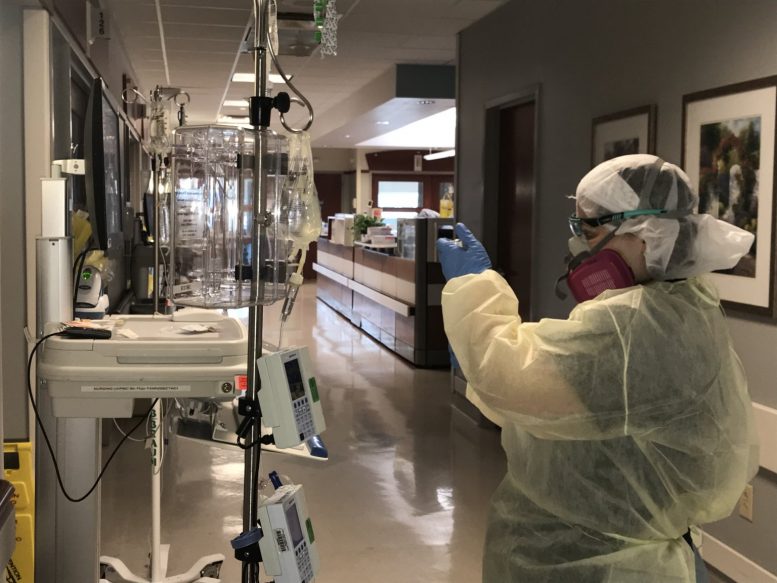COVID-19 is the 4th leading killer of Ohioans this year when compared to 2019 mortality data.
It could quickly become the third, depending on what happens in the three final weeks remaining in 2020.
As of Sunday, 7,492 Ohioans have died from COVID-19, the first having died March 1, according to data from the Ohio Department of Health.
That’s about 2.5-times the national death toll of the terrorist attacks of Sept. 11, 2001 (2,996) or the number of Ohioans who died in the Vietnam War (2,997).
The death toll surpasses the seating capacity (7,000) of the Taft Coliseum at the Ohio Expo Center in Columbus.
The leading causes of death of Ohioans in 2019, per ODH data, were:
- Heart disease (29,159)
- Cancer (25,166)
- Accidents (8,291)
- Chronic lower respiratory diseases (7,168)
- Cerebrovascular diseases (6,504)
- Alzheimer’s (5,235)
- Diabetes (3,876)
“I think that’s very notable. It’s devastating,” said Dr. Michael Mina, an epidemiologist at Harvard University’s T.H. Chan School of Public Health, of COVID-19’s national ascendance as a leading cause of death.
“We have this preventable disease that we could have prevented from spreading.”
Ohio’s deaths are heavily, though not exclusively, concentrated among Ohio’s elders. Nearly 80% of the dead were aged 70 or older when they died. More than 4,000 deaths occurred among residents of long-term care facilities.
However, the young have not been spared.
At least 181 Ohioans younger than 50 years old have died of COVID-19 as of Sunday. Nearly 6,400 in the age range have been hospitalized.
ODH data shows on Dec. 1, Ohio broke a record for most COVID-19 deaths in a single day — 69. The prior peak came April 28, when 64 died.
A major difference between peak death levels of the spring versus today is the corresponding case rates. In late April, about 600 Ohioans were infected per day on average. In early December, about 9,000 were (this figure is likely to rise as delayed data rolls in).
But why are death levels just now reaching the old peaks of the spring?
Mina, speaking to reporters Friday, attributed this to a number of factors: Doctors have learned better techniques to care for patients and have new drugs like remdesivir and dexamethasone at their disposal; states have done an “ok” job keeping the virus out of nursing homes; and younger people are increasingly driving the new cases, who bear a much lower risk in death.
The year’s precise pandemic death toll won’t be finalized in Ohio until at least July 2021, according to Melanie Amato, an ODH spokeswoman.
Nearly 300,000 Americans have died of COVID-19 this year, according to data from Johns Hopkins University.
On Friday, the Food and Drug Administration authorized the emergency use of a COVID-19 vaccine, a landmark human health achievement. However, supply of the vaccine will likely be thin for months. Officials say now, amid the largest case surge to date as the first vaccines go out, is perhaps the most important time to adopt measures like regular testing, robust contact tracing, isolation and masking.
“Now is not the time to say the vaccine is here, let’s not worry anymore,” Mina said.
Speaking to The Council on Foreign Relations, a nonpartisan think tank, last week, CDC Director Dr. Robert Redfield said it’s a “sobering” fact that COVID-19 is the leading cause of death in the U.S. today.
“We are in the time frame now that, probably for the next 60 to 90 days, we’re going to have more deaths per day than we had on 9/11 or Pearl Harbor,” he said. “This is going to be a real unfortunate loss of life as all that we’ve had so far and the reality is the vaccine’s approval is not going to impact that to any degree for the next 60 days.”
***
U.S. Supreme Court rejects Texas suit that tried to overturn election results
WASHINGTON — The Supreme Court on Friday turned aside a Texas lawsuit that sought to derail the presidential election results from four battleground states, despite pressure on the justices from President Donald Trump on social media.
“Texas has not demonstrated a judicially cognizable interest in the manner in which another State conducts its elections,” according to the unsigned court order. “All other pending motions are dismissed as moot.”
A second paragraph from Justice Samuel Alito that was joined by Justice Clarence Thomas stated: “In my view, we do not have discretion to deny the filing of a bill of complaint in a case that falls within our original jurisdiction. See Arizona v. California, 589 U. S. ___ (Feb. 24, 2020) (Thomas, J., dissenting). I would therefore grant the motion to file the bill of complaint but would not grant other relief, and I express no view on any other issue.”
More than half of the Republicans in the U.S. House — 126, with 20 added on Friday after they were left out earlier by a “clerical error” — had signed on to back a brief put forth earlier this week by Texas Attorney General Ken Paxton. Paxton sued to invalidate the voting results of Michigan, Georgia, Wisconsin and Pennsylvania. Among the signers was U.S. Rep. Bob Latta, R-Ohio. READ MORE
Despite scandal, DeWine says he takes corruption seriously
Despite a massive bribery scandal related to a lobbying effort involving his appointees and members of his administration, Ohio Gov. Mike DeWine says his administration takes corruption seriously.
“We always take things seriously,” he said.
DeWine made those comments last Tuesday, less than three weeks after his appointee to chair the Public Utilities Commission of Ohio resigned. The commissioner, Sam Randazzo, left the post after the FBI raided his house and the utility at the center of the scandal, FirstEnergy, disclosed that it gave $4 million to a regulatory official shortly before he assumed his post in early 2019.
“We certainly did not know the huge payment that was made to him,” DeWine said. “We certainly did not know that when he was picked.” READ MORE
As state law expires, proof of work search returns to unemployment benefits
As the pandemic continues to affect jobs in Ohio, state residents applying for new unemployment benefits will once again have to prove they’ve been looking for work to receive benefits.
The Ohio Department of Job and Family Services announced that any new unemployment applicants are required to conduct “work-search activities” unless quarantined or isolated for medical reasons.
The work-search requirement was suspended in House Bill 197, a bill that made changes in response to COVID-19, including absentee voting expansions, educational testing waivers, a pause on utility disconnection and other employment compensation provisions.
Under the employment section of HB 197, individuals weren’t disqualified from receiving unemployment benefits if health or administrative orders didn’t allow them to work. It also suspended the waiting period before receiving unemployment benefits. READ MORE





